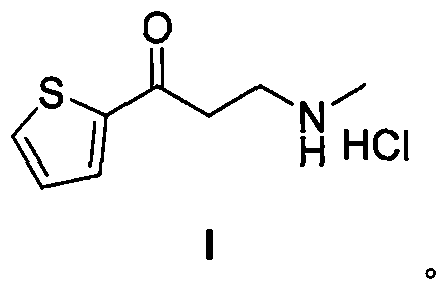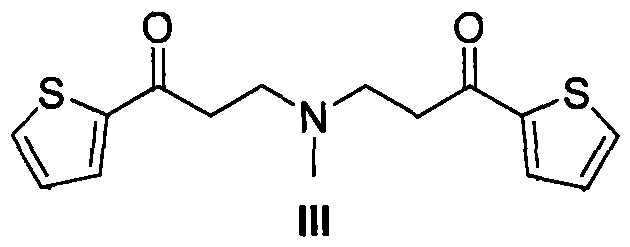Preparation method of duloxetine intermediate
A technology for duloxetine and intermediates, which is applied in the field of preparation of intermediates of pharmaceutical compounds, can solve problems such as difficulties, and achieve the effect of low cost and easy preparation
- Summary
- Abstract
- Description
- Claims
- Application Information
AI Technical Summary
Problems solved by technology
Method used
Image
Examples
Embodiment 1
[0025] Example 1: Synthesis of compound 3-methylamino-1-(thiophen-2-yl)-1-propanone hydrochloride.
[0026]
[0027] Compound II (12.6 g), methylamine hydrochloride (11.4 g) and paraformaldehyde (4.8 g) were dissolved in absolute ethanol (60 mL). The reaction solution was stirred overnight at 80°C. TLC monitored the complete reaction of the starting material, and then added 40% methylamine solution (0.8 g), and then stirred the reaction solution at 80° C. for 8 hours. After the reaction liquid was cooled to room temperature, ethanol (30 mL) was distilled off under reduced pressure, and ethyl acetate (120 mL) was added to the reaction liquid. The reaction solution was cooled to 0-10°C for crystallization. The solid was filtered and washed with cold ethyl acetate (30 mL). The solid was dried to obtain compound I (11.1 g, yield 54%). 1 H-NMRδ(DMSO-d 6 , 300MHz): 2.5(3H,d), 3.2(2H,m), 3.46~3.51(2H,m), 7.29(1H,t), 8.01(1H,d), 8.07(1H,d).
Embodiment 2
[0028] Example 2: Synthesis of compound 3-methylamino-1-(thiophen-2-yl)-1-propanone hydrochloride.
[0029]
[0030] Compound II (12.6 g), methylamine hydrochloride (11.4 g) and paraformaldehyde (4.8 g) were dissolved in absolute ethanol (60 mL), and concentrated hydrochloric acid (0.1 mL) was added. The reaction solution was stirred overnight at 80°C. TLC monitored the complete reaction of the starting material, and then added 40% methylamine solution (0.8 g), and then stirred the reaction solution at 80° C. for 8 hours. After the reaction liquid was cooled to room temperature, ethanol (30 mL) was distilled off under reduced pressure, and ethyl acetate (120 mL) was added to the reaction liquid. The reaction solution was cooled to 0-10°C for crystallization. The solid was filtered and washed with cold ethyl acetate (30 mL). The solid was dried to obtain compound I (14.1 g, yield 68.5%).
Embodiment 3
[0031] Example 3: Synthesis of compound 3-methylamino-1-(thiophen-2-yl)-1-propanone hydrochloride.
[0032]
[0033] Compound II (12.6g), methylamine hydrochloride (11.4g) and paraformaldehyde (4.8g) and absolute ethanol (60mL) were added to the autoclave, and concentrated hydrochloric acid (0.1mL) was added. The reaction solution was stirred overnight at 120°C. TLC monitored the complete reaction of the starting material, and then added 40% methylamine solution (0.8 g), and then stirred the reaction solution at 80° C. for 8 hours. After the reaction liquid was cooled to room temperature, ethanol (30 mL) was distilled off under reduced pressure, and ethyl acetate (120 mL) was added to the reaction liquid. The reaction solution was cooled to 0-10°C for crystallization. The solid was filtered and washed with cold ethyl acetate (30 mL). The solid was dried to obtain compound I (16.86 g, yield 82%).
PUM
 Login to View More
Login to View More Abstract
Description
Claims
Application Information
 Login to View More
Login to View More - R&D
- Intellectual Property
- Life Sciences
- Materials
- Tech Scout
- Unparalleled Data Quality
- Higher Quality Content
- 60% Fewer Hallucinations
Browse by: Latest US Patents, China's latest patents, Technical Efficacy Thesaurus, Application Domain, Technology Topic, Popular Technical Reports.
© 2025 PatSnap. All rights reserved.Legal|Privacy policy|Modern Slavery Act Transparency Statement|Sitemap|About US| Contact US: help@patsnap.com



